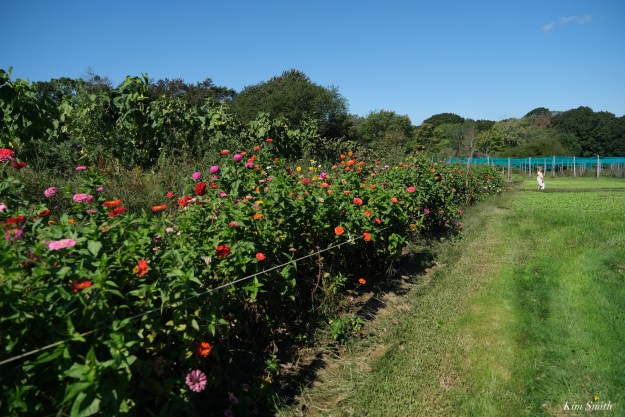A mini swirl of birds was heard overhead before scattering on the beach. At first glance, I thought of the little flock of American Pipits that was here last winter and was hoping for the same. Even more wonderful, it was a flock of eleven Horned Larks! Only ever having seen singleton Horned Larks mixed in with flocks of Snow Buntings, I was overjoyed to see the troupe scampering through the seaweed and along the wrackline.
Horned Larks are called as such not because they have actual horns, but because of the little tufts of feathers that stick out on either side of its head which are sometimes, but not always, visible. Black stockinged legs, feathered knickers, horned and masked, the Larks are wonderfully fun to observe as they forage amongst the seaweed and dried wildflowers.
At 54 seconds, through 1:05, you can clearly see the difference between the male, with the yellow mask, and the female, with the more subdued markings.
I haven’t been able to locate the flock of Horned Larks for a few days and think they have departed our shores. As one wave of travelers moves on, another soon follows. It’s a joy to see the bossy boy Buffleheads have returned to our waterways!
Horned Larks were formerly more prevalent in Massachusetts. With fewer farm fields and an increase in development, much of its breeding habitat has been lost. Look at the two maps created by Mass Audubon. These maps are called Breeding Bird Atlases. The Breeding Bird Atlas 1 was created from data collected during bird counts held from 1974-1979. The BBA2 Atlas was created from data collected from 2007 through 2011. Theses maps are of invaluable help for the future of conservation in Massachusetts and give clear proof of changing bird breeding habits over the past 45 years.
Note that there are fewer dark green squares from Atlas 1 to Atlas 2, especially in the north of Boston region, signaling a decrease in the breeding population of Horned Larks.
 Horned Lark Breeding Bird Atlas 1 (1974-1979)
Horned Lark Breeding Bird Atlas 1 (1974-1979)
“During Atlas 1 Horned Larks were making a living at scattered locations inland, but their stringent habitat requirements meant that they were mostly coastal in distribution. The Marble Valleys had 10% Horned Lark occupancy, likely in areas of abandoned or fallow farmland. The Connecticut River Valley apparently had suitable breeding locations in 14% of the region, both in farm fields and at airports kept free of dense vegetation. Only a small scattering of occupied blocks bridged the gap from the Connecticut River Valley to the coast. The Coastal Plains had breeding Horned Larks on the beaches of Essex and Plymouth Counties, and the Bristol/Narragansett Lowlands reported several instances of inland breeding as well as nests found around the shores of Buzzards Bay. More than 60% of the species’ statewide distribution fell in Cape Cod and the Islands, where sandy dune habitat was readily available for Horned Larks looking to settle down.”
Horned Lark Breeding Bird Atlas 2 (2007-2011)
“Within the three decades between Atlas 1 and Atlas 2, the Horned Lark began to opt out of Massachusetts as a breeding locality. Distribution patterns in Atlas 2 weakly mirror those of Atlas 1: up the Connecticut River, sparsely spread eastward, with the species’ most notable breeding strongholds in the southeastern Coastal Plains and on Cape Cod and the Islands. Horned Larks completely retreated from the far west and almost completely retreated from the Bristol/Narragansett Lowlands. The birds posted only a symbolic guard in Essex County, and even in their stronghold on Cape Cod and the Islands they disappeared from a dozen of the most well-surveyed blocks.”




































































































